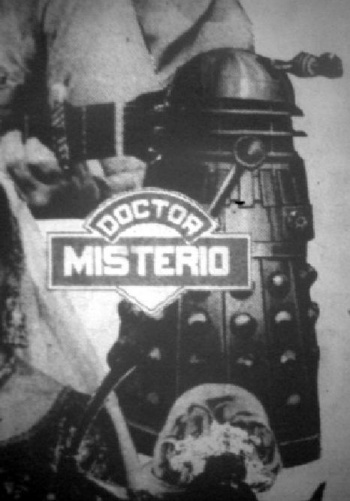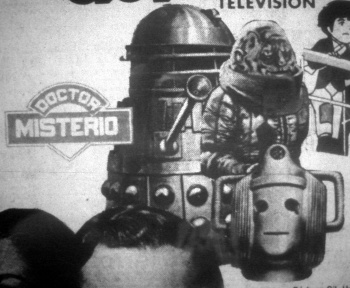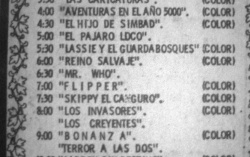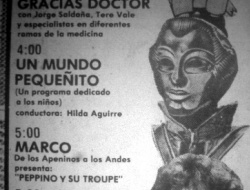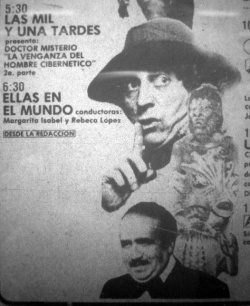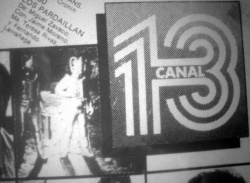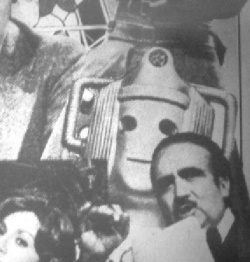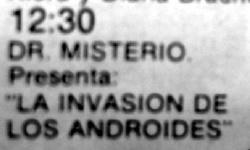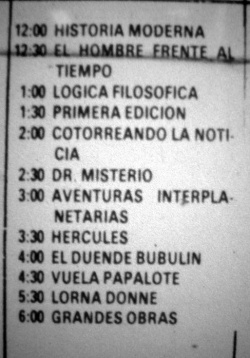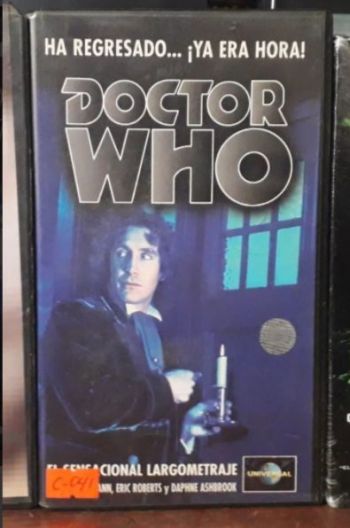Mexico
MEXICO is a country on the Central American isthmus, between the United States and Guatemala.
Profile
| Country Number (25) | 1968 | FIRST and SECOND WAVE |
| Region | Central American | |
| Television commenced | 1950 | |
| Colour System | 1963 | NTSC |
| Population | 1969 | 39 million |
| TV Sets | 1969 | 650,000 |
| Population | 1979 | 62.3 million |
| TV Sets | 1979 | 5.6 million |
| Language/s | Spanish | Dubbed |
Television Stations / Channels
Mexico began its television service in 1950. Colour transmissions began in 1963 using the NTSC colour broadcast system.
Mexico is served by several television stations: in 1968 Doctor Who aired on Canal 5 which was operated by Telesistema Mexicano, a privately-owned station. This was renamed Televisa S A in 1972.
In the late 1970s, Doctor Who entered into syndication, screening on a number of different private stations across the country, such as Canal 13, which served much of the country, and Canal 8 from Monterrey, near the border with Texas.
Language/s
The principal language of Mexico is Spanish. Foreign television programmes are dubbed into Spanish.
DOCTOR WHO IN MEXICO
EL DOCTOR MISTERIO
Mexico was the 25th country to screen Doctor Who. It was the second (after Venezuela) to screen the series in Spanish (see Selling Doctor Who).
PETER CUSHING / Dalek Movies?
As far as we can tell, neither of the two Cushing / Dalek films was released in cinemas in Mexico, but the first was dubbed for and shown on television in Central and South American countries in the late 1970s / early 1980s (see Argentina, Chile and Guatemala).
According to these two dubbing wikis, both films had Spanish language tracks recorded in Mexico, but it's not clear when this was, nor for which medium.
Peter Cushing was voiced by Raúl de la Fuente for the first film, and by Juan Domingo Méndez for the second. Since Méndez died on 2 July 1990, this indicates he did this dubbing work in the 1970s or 1980s. We therefore think these two dubbing sessions were for television, although recorded several years apart, since different actors are credited for Dr Who and Susan for each film.
BBC Records
Mexico is one of the 27 countries named in The Making of Doctor Who 1972 Piccolo edition.
The Seventies records a sale of "(9)" stories by 28 February 1977. The Handbook identifies eight: A, C, E, F, G, J, L and Q; the incorrect total of nine is due to Mexico being listed twice under J in the 1977 document.
In DWM, Mexico is identified in 29 story Archives: 12 Hartnells - the same as the 1977 list above, plus B, K, N and R; and 17 Tom Bakers: all the stories from 4A to 4Z, but omitting 4A, 4L, 4R, 4X, 4Y and 4Z.
DWM
A letter from Martin Bonfil Olivera of La Candelaria, Coyoaca'n [sic] in Mexico City appeared in DWM #62 (March 1982). He writes: "I have been a fan of the Doctor since the early 70s, when the William Hartnell series were shown here. But I could see only a few episodes, because the series wasn't very successful and was taken off the air. After about 8 years, the state tv station showed the early Tom Baker episodes, from Robot to Invasion of Time. Since then they have been periodically re-showing those episodes."
Assuming Olivera wrote the letter in late 1981, he is accurate with respect to his comments about the Baker repeats, the last of which aired in August 1981. Working back 8 years from 1980, this takes us to 1972, when indeed there was a run of repeats on Canal 5, one that was cut short mid-story, exactly as Olivera describes.
Stories bought and broadcast
WILLIAM HARTNELL
Twelve stories, 56 episodes:
| A | An Unearthly Child | 4 |
| B | The Daleks | 7 |
| C | Inside the Spaceship | 2 |
| E | The Keys of Marinus | 6 |
| F | The Aztecs | 4 |
| G | The Sensorites | 6 |
| J | Planet of Giants | 3 |
| K | The Dalek Invasion of Earth | 6 |
| L | The Rescue | 2 |
| N | The Web Planet | 6 |
| Q | The Space Museum | 4 |
| R | The Chase | 6 |
- For the Spanish episode titles, go to: SPANISH
Mexico therefore bought the standard package of the GROUP A to E of the William Hartnell stories that were dubbed into Spanish.
The programme was supplied as 16mm black and white film prints with Spanish soundtracks.
This link is to a voice recording of the opening voice-over giving the series title:
Origin of the Prints?
Mexico was the second of the three known Spanish-speaking countries to screen the William Hartnell stories. The previous country was Venezuela, where some of the episodes had aired from early 1967 to early 1967. Given the crossover of screenings by the two countries, Mexico must have had its own set of prints.
As covered in the Spanish page, Venezuela appears to have been responsible for dubbing the first seven serials, with the other five dubbed by the Mexican broadcaster.
TOM BAKER
23 stories, 98 episodes:
| 4A | Robot | 4 |
| 4B | The Sontaran Experiment | 2 |
| 4C | The Ark in Space | 4 |
| 4D | Revenge of the Cybermen | 4 |
| 4E | Genesis of the Daleks | 6 |
| 4F | Terror of the Zygons | 4 |
| 4G | Pyramids of Mars | 4 |
| 4H | Planet of Evil | 4 |
| 4J | The Android Invasion | 4 |
| 4K | The Brain of Morbius | 4 |
| 4L | The Seeds of Doom | 6 |
| 4M | The Masque of Mandragora | 4 |
| 4N | The Hand of Fear | 4 |
| 4P | The Deadly Assassin | 4 |
| 4Q | The Face of Evil | 4 |
| 4R | The Robots of Death | 4 |
| 4S | The Talons of Weng-Chiang | 6 |
| 4V | Horror of Fang Rock | 4 |
| 4T | The Invisible Enemy | 4 |
| 4X | Image of the Fendahl | 4 |
| 4W | The Sun Makers | 4 |
| 4Y | Underworld | 4 |
| 4Z | The Invasion of Time | 6 |
- For the equivalent Spanish story titles, go to: SPANISH
Mexico therefore bought the standard package of Tom Baker stories that was packaged for the North, Central and South American markets by Time Life Television.
The programme was supplied as NTSC colour video tapes with Spanish soundtracks.
Mexico was five days ahead of Chile in screening the Tom Baker episodes. Curiously, some of the Chilean episode titles differ from those used in Mexico - see the Spanish page for a list of the different translations.
Transmission
WILLIAM HARTNELL
NOTE: IF the newspaper TV listings are completely accurate, then the way Doctor Who screened in Mexico was a very confusing affair, with stories airing in a random order, with some episodes not screening at all, or being scheduled during an entirely different serial.
To make some sense out of the screening history, we have ASSUMED that the listings were not always accurate, and that on some occasions the billed episode was not necessarily the episode that did air that night, and that additional episodes aired on Fridays even when there was no billing.
FIRST RUN
The series started on Monday, 25 March 1968, and screened weekdays at 6.30pm. No titles were given for the first eleven episodes; the 9 April episode was billed as part four of The Sensorites. If that serial commenced on 4 April, then it's only the first eight episodes that are not identifiable.
Since it does not get another billing until the run of repeats, The Daleks must have aired at this time. The big question is, what was the stray eighth episode? It might have been part one of An Unearthly Child, but that may also have been the episode billed as "Senorita Sistema Solar" on 2 May; did it screen twice within such a very short time? Or was one of these first eight episodes pre-empted? Did the series perhaps start on Tuesday, 26 March instead?
(The Spanish title for the very first episode was "Una Niña Que No Es De Este Mundo", however two of the Mexican newspapers published the title "Senorita Sistema Solar" for the episode that aired on 2 May 1968, but this appears to have been an accidental substitution of the title of an episode of the Hanna Barbera animated series The Jetsons (called "Los Supersonicos" in Mexico), which aired an hour ahead of "Dr Misterio" in 1968. "La Senorita Sistema Solar" was the 20th episode of Los Supersónicos.)
As noted below, the 2 May episode had the Authorisation Code 4919-A, which was the lowest of all the codes assigned to the episodes of "Dr Misterio", which suggests that this episode was actually a repeat of An Unearthly Child part one.
BUT it is also possible that Doctor Who was pre-empted by an episode of The Jetsons, and the papers published the correct episode title but the wrong series name.
From the week commencing 15 April, episodes no longer regularly aired on Fridays. However, in order to account for "missing" episodes, it does seem likely that episodes did occasionally air on Friday but were not billed.
There was no episode billing for Monday, 20 May 1968, however since there is no listing for part three of The Space Museum, it seems likely that that episode did air that night.
According to the newspaper listings, the stories aired in this order:
- An Unearthly Child part one only?
- The Daleks?
- The Sensorites
- The Dalek Invasion of Earth
- The Web Planet but missing one or two episodes?
- An Unearthly Child part one only again?
- Planet of Giants
- Inside the Spaceship part one only?
- The Rescue part two only?
- The Space Museum but not part three?
- The Chase but not part three?
- The Keys of Marinus but not part two?
- The Aztecs
53 of the 56 episodes had aired between 25 March and 13 June.
REPEATS # 1
The first run was followed by a run of repeats, which aired in this order:
- The Sensorites
- Planet of Giants
- The Dalek Invasion of Earth
- The Rescue
- The Web Planet but not part six?
- The Space Museum but not part three?
- The Chase parts one and two
- An Unearthly Child part two only
- The Chase parts three to six
- The Daleks
- Inside the Spaceship
- The Keys of Marinus
- The Aztecs
Midway through The Chase, on 5 August, part two of An Unearthly Child aired on its own.
REPEATS # 2
Commencing from 16 September 1968 was a further repeat run; between Planet of Giants and The Rescue, parts two, three and four of An Unearthly Child aired, which was (it would seem) the first time for the latter two of those episodes:
- The Sensorites
- Planet of Giants but not part three?
- An Unearthly Child parts two, three, four
- The Rescue
- The Web Planet parts one and two only
The series took a two week break from 14 October while the television schedules were dominated with full day coverage of the 1968 Summer Olympics that were being held in Mexico City from 12 to 27 October.
The series resumed on Monday, 21 October, presumably from where it left off, with two more episodes of The Web Planet. (The other two episodes from this serial could not be accounted for; they may have aired during breaks in the Games' coverage without being scheduled.)
- The Web Planet two more episodes?
- The Space Museum
- The Daleks
- The Keys of Marinus parts four, five and six only?
The final regular episode (The Keys of Marinus part six) aired on Thursday, 14 November 1968. There were no further listings in 1968, or during 1969.
There are 134 airdates accounted for in 1968, plus three dates on which it is not clear whether the series aired, and one day for which the paper was missing, giving us potentially 138 episodes in total.
In summary – and with a fair bit of manipulation of the listed episode versus what SHOULD have aired instead - with the possible exception of three from the first serial, in 1968 all episodes aired twice, with a handful airing for a third time:
- An Unearthly Child = once, but parts one and two twice?
- The Daleks = three times
- Inside the Spaceship = twice
- The Keys of Marinus = twice, but parts 4-6 three times?
- The Aztecs = twice
- The Sensorites = three times
- Planet of Giants = three times
- The Dalek Invasion of Earth = twice
- The Rescue = three times
- The Web Planet = three times, but parts 5-6 only twice?
- The Space Museum = three times, but part 2 only twice?
- The Chase = twice, but part 3 only once?
REPEATS # 3
A third (and final?) re-run aired on Mexico City's Canal 5 in 1972. It was this run that Martin Bonfil Olivera saw. These screened four days a week (with no episode on Mondays), starting on Thursday, 6 January 1972, at 6.30pm. For the first time, the episodes aired in correct story order. This listings for this run give the title of the first episode as "Una Niña Que No Es De Este Mundo".
The 34th and final episode of this run aired Friday, 3 March 1972, and was part two of The Dalek Invasion of Earth; as noted by Olivera in DWM, this repeat run appears to have been dropped mid-story due to poor ratings. There were certainly no further listings for the series for the rest of 1972 or in 1973.
REPEATS # 4?
According to Televisa SA, the William Hartnell serials also aired in Ensenada on the Baja California peninsula around the same time as the Canal 5 screenings, circa 1973. The local station there was XHS-TV, Canal 23.
XHS-TV was a sister station to XEWT-TV channel 12 in Tijuana, whose coverage extended across the US border and was available in San Diego, California. If XEWT and XHS piggy-backed each other, that would have made those repeats the first time since 1965 that any William Hartnell stories had been available to viewers in the United States -- albeit understood only by those who spoke Spanish!
Newspapers from Ensenada have not been located. The San Diego edition of TV Guide and the San Diego Union did include TV listings for XEWT during 1972, 1973 and 1974, however there was no sign of Dr Misterio on that channel. It should be noted that both publications tended to list only some of the daily XEWT schedules (perhaps they only included those programmes that would be of interest to American viewers, or which also had English soundtracks?) so it's possible that Dr Misterio did air but simply wasn't included in either American publication.
Fate of the Prints?
According to the section in this BLOG that is headed "La catástrofe en México", the poster writes:
- La primera serie del Dr. Who se transmitió en México en 1966 por el canal 13, la serie duró dos años en el aire hasta la llegada de las olimpiadas de México 68. Debido a que el canal 13 no contaba con cintas virgenes para la grabación de los juegos, decidió usar las cintas de algunos de los programas de su repertorio para grabarlos, esto incluyo la serie del Doctor Who. Cuando esto se hizo público, muchos de los fanáticos de la serie se indignaron con el canal, esto llegó a conocimiento de la BBC, quién demandó al canal y no permitió que el resto de la serie llegara a México. Se especula que algunos de los altos funcionarios del canal se quedaron con copias del programa. La serie volvió a transmitirse durante los años 80´s, de nuevo por el canal 13 a las 11 de la mañana con el cuarto Doctor, interpretado por Tom Baker. Pocos son los que la recuerdan.
The basic content of this BLOG (which it must be noted gets the year and channel number wrong) is that the episodes of Doctor Who might have been converted onto videotape prior to transmission. The site states that the BBC wanted to retain those tapes for its own use, but Telesistema wiped them as they needed the tapes to record coverage from the Mexico Olympic Games. This act apparently displeased the BBC, and as a result, further episodes of Doctor Who were not supplied to Mexico for ten years...
(We have to admit that the idea that the BBC would cease providing Mexico with any further programmes because of this business with the tapes seems a bit far-fetched, so where did the author of the blog get this notion from if it wasn't something they had themselves researched and discovered to be the case?)
Televisa SA was contacted by Paul Vanezis in 1984, and they replied confirming that they had last shown the series in Ensenada in 1973, but there was nothing in their letter to indicate what had happened to their films, nor any hint that they still had them.
TOM BAKER
Eleven years after the first Doctor aired in Mexico, the Tom Baker stories screened in syndication, airing on several different stations across the country.
We only have airdates for two of these: Canal 13 (Mexico City), and Canal 8 (in Monterrey).
CANAL 13 (Mexico City)
The fourth Doctor episodes aired weekly on Canal 13 (Channel 13) Fridays at 5.30pm, commencing 4 May 1979. Two episodes aired back-to-back in a one hour timeslot.
The series featured as part of the "LAS MIL Y UNA TARDES" ("A Thousand and One Afternoons") line-up of children's programmes. (This is a pun on the Spanish title for the book Arabian Nights, which is known as "Las Mil y Una Noches" ("A Thousand and One Nights"). And the fact that TARDES is very similar to TARDIS is probably purely coincidental!)
The stories of seasons 12 and 13 generally aired in production code order, although Revenge of the Cybermen and Genesis of the Daleks did actually play in the correct narrative order.
There were no billings for The Ark in Space, The Deadly Assassin or Image of the Fendahl, however there are enough airdates to account for these; certainly The Ark in Space aired in the two weeks between The Sontaran Experiment and Genesis of the Daleks. And as there were more than three hour-long billings for "La Invasion del Tempo", in the case of Image of the Fendahl and The Deadly Assassin, both appear to have aired between Underworld and The Invasion of Time, with the latter maybe even immediately before The Invasion of Time. Although some of these timeslots are recorded as 5.30 to 6.00pm, at least two of them have to be an hour, otherwise two episodes are not accounted for.
From the 7 March 1980 episode, the timeslot shifted to 6.00pm for a few weeks, before switching to a half-hour, single-episode 5.30pm slot from 2 May.
REPEATS # 1
From 30 May 1980, the week after The Invasion of Time parts five and six, a run of repeats began, consisting of four season 12 Baker stories; the first serial is named as "Los Hombres de Metal" ("The Men of Metal"), which is probably (a re-titled?) Revenge of the Cybermen, rather than Robot.
Several episodes in the 1979 to 1980 run were pre-empted due to football or, as was the case in August 1980, coverage of the Moscow Summer Olympics.
The repeats ended on 26 September 1980, with parts five and six of Genesis of the Daleks.
REPEATS # 2
Ten months later, on Wednesday, 1 July 1981, El Doctor Misterio returned to Canal 13, playing episodically, five days a week at 12.30pm in the afternoon. The first nine Baker serials aired, although curiously, The Sontaran Experiment played twice; the second and final part of that serial closed the repeat run on 21 August 1981.
CANAL 8 (Monterrey)
The Tom Baker package also aired on Canal 8 in Monterrey, commencing on Tuesday, 29 April 1980 at 4.30pm, in half hour slots. None of the TV listings gave story titles.
From June 1980, the slot changed to the earlier time of 2.30pm. A number of the episodes were pre-empted, such as to allow for coverage from the 1980 Moscow Olympics during July 1980. Several papers were missing, so it is not certain whether the series aired on those dates.
The papers for 30 September and 7 October were missing, but from 14 October the 2.30pm slot was taken by a series called "Los Tresors del Gato", making the last known billed episode for "Dr Misterio" in 1980 that for 23 September.
The available collection of Monterrey's El Norte stopped at November 1980. It is more than likely that the series resumed at some point during 1981.
There were 17 clear listings, four papers missing and three pre-emptions. If the series aired on the dates without papers, there would have been 20 episodes, which potentially makes this 1980 run all of season 12 – Robot to Revenge of the Cybermen.
There is no clear record that Mexico screened Doctor Who again after those early 1980s repeats.
PAUL McGANN
The 1996 Paul McGann TV Movie was available as a subtitled Rental VHS circa late 1996 (released by MCA/Universal/CIC Video and Videovisa) in English with Spanish subtitles.
The tape was titled "DOCTOR WHO", rather than "Doctor Misterio". The cover tagline was "HA REGRESADO… ¡YA ERA HORA!" (HAS RETURNED … IT WAS ON TIME!).
The subtitling was created by a studio located in Los Angeles. The TARDIS was called "El TYDREE", which stands for "Tiempo y Dimensiones Relatívos En Espacia (or Espaciales)".
From February 1999, the film was available via the HBO OLE cable station.
TV listings
| ← AIRDATES ...... (CLICK ICON TO GO TO TABLE SHOWING EPISODE BREAKDOWN AND AIRDATES - N/S = story title is Not Stated) |
TV listings have been obtained from the newspapers El Día and El Excelsior, from Mexico City, and El Norte from Monterrey.
1960s
As noted in the Transmission history above, the newspapers listings provide the titles for the vast majority of the episodes, however, due to the number of episodes that are NOT listed, and the frequency in which episodes are billed out of sequence, either the newspapers were provided with the wrong programme from the broadcaster, OR, the broadcaster simply failed to realise the serialised nature of the series and did indeed screen the series exactly as it was billed.
Unusually for a Spanish language country, the series' title was billed as "Doctor Who" or "Dr Who" rather than "El Doctor/Dr Misterio"; it wasn't until towards the end of the run (from 3 October 1968) that the Spanish alternative was adopted for the listings for both papers (which indicates that the two publications were provided with the same programme information from the broadcaster).
Listings sometimes say "Doctor/Dr Who proyecta...", "Doctor/Dr Who presenta...", "Doctor/Dr Who en..." before each episode title.
Curiously, the Excelsior also included the Authority Code, which appears to be the censors' classification reference; there are a few occasions where the same code has been printed against two different episodes – for instance 21136-A appears against The Web Planet part one and The Keys of Marinus part six - but presumably these duplications are merely printing errors.
The "A" classification stood for "Appropriate for All Ages, parental guidance is recommended for children under 7 years (some profanity, sexual references, violence or crude humor) (broadcast between 05:00 and 20:00 were required to be A rated and can be broadcast any time).
Some of the Authorisation Codes were "Pend" (i.e. Pending).
The 'lowest' of these numerical codes is 4919-A, which was assigned to the episode identified as "Senorita Sistema Solar", which based on it being the "lowest" code does support our belief that this was An Unearthly Child. The 'highest' known was 23076-A, for part two of The Daleks, which indicates the codes were not assigned by story order.
1972
The billings in El Excelsior always gave the series titles as "DR WHO" rather than "Doctor Misterio". "DR WHO" stands out as being the only programme listed that was not in colour!
For the 1 January 1972 billing, a misprint gave the title as "MR WHO"!
1979-81
The daily TV schedules for Canal 13 were printed exactly the same way in both papers and appear in the form of a box-out which was illustrated with a collage of images from the featured programmes.
The series was called "DR / DOCTOR MISTERIO". The illustrations that accompanied the listings have been cropped from Chris Achilleos's artwork from the cover of Target's 1975 Doctor Who Monster Book, or from the cover of the Time Life Television sales brochure (see the United States page), which in turn featured Achilleos's painting from The Second Doctor Who Monster Book.
Listings sometimes say "DR MISTERIO Presenta" (Presents) or "CAPITULO" (Chapter) before each episode title.
For the Monterrey listings, none of the episodes is identified by story title, so we are unsure of the order in which the serials aired.
Websites
There are a number of Mexican and Spanish-language websites which refer to the Mexican broadcasts of the series:
Mexico in Doctor Who
- The Aztecs is set in Mexico.
- While exploring the caves of Atlantis, Polly finds a souvenir object (a vase?) marked "Mexico Olympiad" (The Underwater Menace).
- Salamander hailed from Mérida, in the Yucatan area of Mexico. The Doctor thought he might be from Quintana Roo (The Enemy of the World).
- Artoro Villa from the Mexico Civil War Zone, fought in The War Games.
- The Doctor refers to the volcanic mountain Popocatepetl (The Brain of Morbius)

